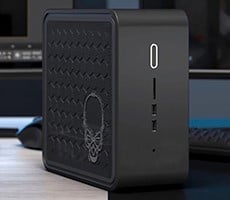Alienware X51 R2 Small Form Factor Game PC, Haswell-Infused
|

Intel's Haswell architecture represents a "Tock" in Intel's "Tick-Tock" upgrade cycle, meaning it's a major update and not simply a minor revision. SiSoft SANDRA's synthetic benchmarks do a good job underscoring the strength of this architectural change, especially in comparison to the original X51. It also boasts much stronger integrated graphics, though that's of little benefit in this instance since there's a discrete GPU backing up the CPU.

For whatever reason, the X51 R2 posted one of the slower memory scores, though we're talking relatively minute differences for the most part. To wit, the real-world difference between 16.7GB/s (X51 R2) versus 17.5GB/s (X51) is not something you're likely to notice outside of benchmarking.
The same isn't true for the Physical Disks benchmark. These scores are based on read speeds, and the Micron RealSSD C400 256GB SSD really flies. It's 513MB/s is the fastest of the bunch, edging out the iBuyPower Revolt and running circles around systems using a mechanical hard drive.
For good measure, we ran ATTO and recorded a read speed of 535.27MB/s and write speed of 275.6MB/s. In terms of real-world performance, the X51 R2 is highly responsive, just as we've come to expect from SSD-based setups.
|
Maxon's Cinebench R11.5 benchmark is based on Maxon's Cinema 4D software used for 3D content creation chores and tests both the CPU and GPU in separate benchmark runs. On the CPU side, Cinebench renders a photorealistic 3D scene by tapping into up to 64 processing threads (CPU) to process more than 300,000 total polygons, while the GPU benchmark measures graphics performance by manipulating nearly 1 million polygons and huge amounts of textures.
The XPS 18 sat at the bottom of the pack in Cinebench's CPU tests, and though it trailed by a small margin, the real takeaway here is that for all of the system's flexibility, one thing you're not going to be doing is a lot of CAD work or 3D design. It doesn't have the horsepower required for such tasks.

Cinebench has one goal and one goal only: bring your system to its knees. It doesn't take full advantage of Haswell's architectural changes and is mainly interested in cores and clockspeed. The Core i7 4770 chip found in the X51 R2 is certainly a faster processor than the Core i7 2600, but both are quad-core parts clocked at 3.4Ghz.

The OpenGL portion of the test told a different story. Armed with a GeForce GTX 670 graphics card, the X51 R2 was able to post a mighty impressive 77.77 fps, which is one of the higher scores we've seen.







